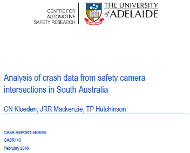Article from: www.thenewspaper.com/news/64/6402.asp
2/16/2018
Ten-Year Australian Study Finds Little Red Light Camera Benefit
The majority of South Australian intersections were worse off after installing ticketing cameras according to long-term study.
 Red light cameras and speed cameras have failed to make South Australian streets demonstrably safer, according to a ten-year study by the University of Adelaide's Centre for Automotive Safety Research released last week. The report prepared for the South Australian Department of Planning Transport and Infrastructure did come up with the positive conclusions that the government officials sought to support their existing policies, but the underlying data tell a far more disappointing story.
Red light cameras and speed cameras have failed to make South Australian streets demonstrably safer, according to a ten-year study by the University of Adelaide's Centre for Automotive Safety Research released last week. The report prepared for the South Australian Department of Planning Transport and Infrastructure did come up with the positive conclusions that the government officials sought to support their existing policies, but the underlying data tell a far more disappointing story.
The study examined accident data from 35 intersections equipped with cameras that issue both red light and speeding citations. Data from five years before camera installation were compared with five years of data afterward. At 14 locations, the total number of injury accidents increased or stayed the same after the cameras were installed. At 21 other intersections, accidents decreased.
Because proper control group intersections were not used to account for the effects of other variables that may have influenced accident trends, the researchers decided to compare the accidents in the intersection approaches where the cameras were watching (called "relevant" accidents) to accidents in the directions of travel where the cameras were not active (called "non relevant").
"This gives the effect at each site on relevant crashes over and above the effect seen in non-relevant crashes," the researchers explained.
After making this analysis, the data show that 19 intersections were worse off with cameras, while only 16 were better off. The latter number may be too high, as the researchers admitted they were making the most of a limited dataset. The decision officials made to place cameras at accident-prone intersections, as opposed to placing them randomly, has a significant effect on the quality of the data.
"The selected sites, having high crash rates, may also have other treatments applied," the study acknowledged. "Part of any apparent reduction in crashes could be the result of these additional treatments."
A statistical error known as regression to the mean may also have created an illusion of safety improvement at some of the camera-enforced intersections.
"The selection of sites for installation of a [red light/speed] camera was based, at least in part, on the crash history of those sites," the report explained. "This means that sites where there was a random increase in crashes in the years before selection would be more likely to be selected and then revert back to their normal level of crashes in the years after. This gives an apparent additional effect of treatment that is not real."
A copy of the study is available in a 300k PDF file at the source link below.
Source: Analysis of crash data from safety camera intersections in South Australia (University of Adelaide, 2/8/2018)
Permanent Link for this item
Return to Front Page
 Red light cameras and speed cameras have failed to make South Australian streets demonstrably safer, according to a ten-year study by the University of Adelaide's Centre for Automotive Safety Research released last week. The report prepared for the South Australian Department of Planning Transport and Infrastructure did come up with the positive conclusions that the government officials sought to support their existing policies, but the underlying data tell a far more disappointing story.
Red light cameras and speed cameras have failed to make South Australian streets demonstrably safer, according to a ten-year study by the University of Adelaide's Centre for Automotive Safety Research released last week. The report prepared for the South Australian Department of Planning Transport and Infrastructure did come up with the positive conclusions that the government officials sought to support their existing policies, but the underlying data tell a far more disappointing story.